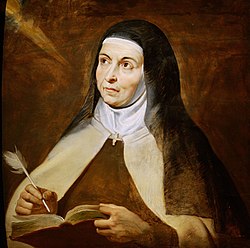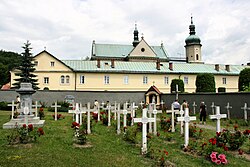Ordo Fratrum Carmelitarum Discalceatorum Beatae Mariae Virginis de Monte Carmelo | |
 Coat of arms of the order | |
| Abbreviation | OCD |
|---|---|
| Formation | 1562 |
| Founder | Teresa of Ávila John of the Cross |
| Type | Mendicant Order of Pontifical Right (for Men) |
| Legal status | Institute of Consecrated Life |
| Headquarters | Casa Generalizia dei Carmelitani Scalzi, Corso d’Italia 38, 00198 Rome, Italy |
| Membership | 3,978 members (includes 2,897 priests) [1] (2022) |
Superior General | Miguel Márquez |
| Affiliations | Catholic Church |
| Website | carmelitaniscalzi |
The Discalced Carmelites, formally the Order of the Discalced Brothers of the Blessed Virgin Mary of Mount Carmel (Latin : Ordo Fratrum Carmelitarum Discalceatorum Beatae Mariae Virginis de Monte Carmelo) or the Order of Discalced Carmelites (Latin: Ordo Carmelitarum Discalceatorum; abbrev.: OCD; sometimes called in earlier times Latin : Ordo Carmelitarum Excalceatorum), is a mendicant order in the Catholic Church with roots in the eremitic tradition of the Desert Fathers. The order was established in the 16th century, pursuant to the reform of the Carmelites of the Ancient Observance, by two Spanish saints, Teresa of Ávila and John of the Cross. Discalced is derived from Latin, meaning "without shoes".
Contents
- Background
- Foundation of the Discalced Carmelites
- Carmelite charism
- Bishops
- Living bishops (4 archbishops, 18 bishops)
- Deceased Bishops (7 cardinals, 14 archbishops, 52 bishops)
- Communities of Discalced Carmelite tradition
- See also
- References
- External links
The third order, which is affiliated to the Discalced Carmelites, is the Secular Order of Discalced Carmelites.
The Discalced Carmelites are friars and nuns who dedicate themselves to a life of prayer. The Carmelite nuns live in cloistered (enclosed) monasteries and follow a completely contemplative life. The Carmelite friars, while following a contemplative life, also engage in the promotion of spirituality through their retreat centres, parishes, and churches. Lay people, known as the Secular Order, follow their contemplative call in their everyday activities. Devotion to the Virgin Mary is a characteristic of Carmelites[ which? ] and is symbolised by wearing the brown scapular. [2]





